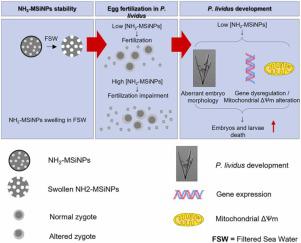Environmental Toxicology and Pharmacology ( IF 4.3 ) Pub Date : 2022-08-10 , DOI: 10.1016/j.etap.2022.103956 Stefano Tacconi 1 , Simone Augello 1 , Francesca Persano 2 , Carolina Sbarigia 1 , Elisabetta Carata 3 , Stefano Leporatti 4 , Marco Fidaleo 5 , Luciana Dini 5

|
Nanoparticles have found use in a wide range of applications, mainly as carriers of active biomolecules. It is thus necessary to assess their toxicity for human health, as well as for the environment, on which there is still a gap of knowledge. In this work, sea urchin Paracentrotus lividus, a widely used model for embryotoxicity and spermiotoxicity, has been used to assess potential detrimental effects of amino-functionalized mesoporous silica nanoparticles (NH2-MSiNPs) on embryonic development. Specifically, gametes quality, embryogenesis morphological and timing alterations, and cellular stress markers, such as mitochondrial functionality, were assessed in presence of different concentrations of NH2-MSiNPs in filtered seawater (FSW). Furthermore, dorsal-ventral axis development and skeletogenesis were characterized by microscopy imaging and gene expression analysis. NH2-MSiNPs determined a strong reduction in the egg fertilization rate. Consequently, the presence of NH2-MSiNPs resulted detrimental in P. lividus embryonic development, with severe morphological alterations correlated with an increased embryos mortality. Finally, NH2-MSiNPs treatment was responsible for other toxic effects, such as reduced mitochondrial function and skeletogenesis alterations, according to the reduced mineralization sites in the endoskeleton formation and the related genes altered expression. Taken together, these results suggest the potential toxic effects of NH2-MSiNPs on the marine ecosystem, with consequences for the development and reproduction of its organisms. Despite their promising potential as carriers of biomolecules, it is pivotal to consider that their uncontrolled use may result harmful to the environment and, consequently, to living organisms.
中文翻译:

氨基功能化介孔二氧化硅纳米粒子 (NH2-MSiNPs) 损害海胆 Paracentrotus lividus 的胚胎发育
纳米粒子的应用范围很广,主要用作活性生物分子的载体。因此,有必要评估它们对人类健康和环境的毒性,在这方面仍存在知识空白。在这项工作中,海胆Paracentrotus lividus是一种广泛使用的胚胎毒性和精子毒性模型,已被用于评估氨基官能化介孔二氧化硅纳米粒子 (NH 2 -MSiNPs) 对胚胎发育的潜在不利影响。具体而言,在不同浓度的 NH 2存在下评估配子质量、胚胎发生形态和时间变化以及细胞应激标志物,例如线粒体功能。-过滤海水 (FSW) 中的 MSiNPs。此外,通过显微镜成像和基因表达分析对背腹轴发育和骨骼形成进行了表征。NH 2 -MSiNPs 确定了卵子受精率的强烈降低。因此,NH 2 -MSiNPs的存在对青灰鱼胚胎发育有害,严重的形态学改变与胚胎死亡率增加相关。最后,NH 2根据内骨骼形成中矿化位点的减少和相关基因的表达改变,-MSiNPs 治疗是造成其他毒性作用的原因,例如线粒体功能降低和骨骼发生改变。总之,这些结果表明 NH 2 -MSiNPs 对海洋生态系统的潜在毒性作用,对其生物体的发育和繁殖产生影响。尽管它们作为生物分子载体的潜力很大,但关键是要考虑到它们不受控制的使用可能对环境有害,从而对生物体有害。


























 京公网安备 11010802027423号
京公网安备 11010802027423号